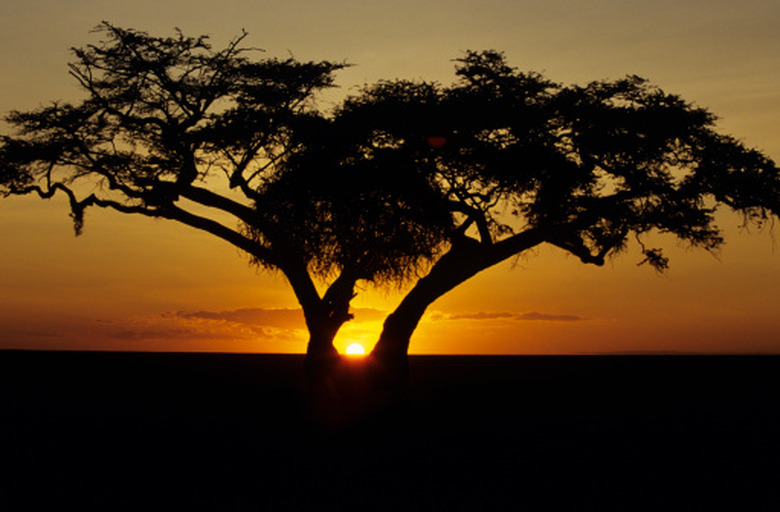What Types Of Trees Are Found In Grassland Biomes?
Biomes are what the University of California Museum of Paleontology calls "the world's major communities, classified according to the predominant vegetation." They also are identified by the ways that plants and animals adapt to survive. As the term "grassland biome" suggests, grasses rather than trees or large shrubs dominate such environments. However, some trees survive in grassland environments, which typically get little rain. These trees often share such characteristics as fire-resistant bark and efficient water retention. Trees that survive such environments range from the oaks of the Eurasian steppe and the ombu on the South American pampas to the cottonwoods of the North American prairie and the figs and date palms of the African savanna.
Eurasian Steppe
Eurasian Steppe
The Eurasian steppe biome is typically very dry and does not supply enough moisture for most trees to grow. Summers on the steppe can be warm, and winters are often quite cold. There generally is a transitional zone, however, where oak, birch and aspen trees grow, although grasses are the main steppe plant.
North American Prairie
North American Prairie
Trees that grow on the North American prairie include red oaks, Burr oaks and plains cottonwoods. Many of these trees mark where homesteads were many years ago. The North American prairie has enough precipitation to support grasses, but generally not many trees, since drought and fire inhibit their growth. According to the University of California Museum of Paleontology, tall-grass prairies are often more humid and wet, while short-grass prairies are generally hotter and drier, with harsher winter conditions.
South American Pampas
South American Pampas
The evergreen ombu trees are among the few species that have adapted to thrive in the Pampas ecosystem of South America. The Pampas are mainly in Argentina and part of Uruguay. Fires frequently sweep through them, destroying many trees because of their shallow root systems. The fire-resistant ombu does not need much water to survive, though, because its trunk stores water. Additionally, its sap is poisonous, so the trees are not eaten by cattle and are immune to such pests as locusts. Winds are frequent on the Pampas, and the weather is usually warm and humid, with summer being the dry season.
African Savanna
African Savanna
The few trees in the savannas, which make up almost half of Africa's surface area, are able to survive because they retain moisture and have fire-resistant bark. According to Serengeti National Park, the savanna environment includes such trees as the sausage tree (Kigelia africana); the strangler fig (Ficus thonningii); the wild date palm (Phoenix reclinata); the Yellow Fever tree (Acacia xanthophloea); the umbrella thorn tree (Acacia tortilis); the whistling thorn (Acacia drepanolobium); and the toothbrush tree (Salvadora persica). The savannas, according to the University of California Museum of Paleontology, are classified as warm areas with 20 to 50 inches of rain per year, most of which falls during a period of six to eight month. Fires are common during the rest of the year.
Cite This Article
MLA
Snow, Katherine. "What Types Of Trees Are Found In Grassland Biomes?" sciencing.com, https://www.sciencing.com/types-trees-found-grassland-biomes-8704083/. 22 November 2019.
APA
Snow, Katherine. (2019, November 22). What Types Of Trees Are Found In Grassland Biomes?. sciencing.com. Retrieved from https://www.sciencing.com/types-trees-found-grassland-biomes-8704083/
Chicago
Snow, Katherine. What Types Of Trees Are Found In Grassland Biomes? last modified August 30, 2022. https://www.sciencing.com/types-trees-found-grassland-biomes-8704083/
